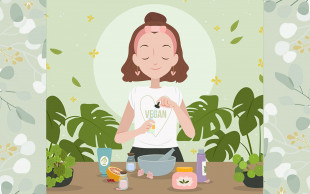Topaz was born in 1999 to a family of engineers and scientists who all believed she’d get a Harvard MBA and be the next Einstein. Now, she is a published poet, actress, entrepreneur, musician and multidisciplinary artist.
Her kindergarten teacher told her about a writing contest when she was fiive. The prompt was “I Wonder Why.” So she came home, didn’t tell anybody, used some printer paper, and over the span of three days past her bedtime, wrote “I wonder why kids have to do what their parents tell them to do.” She forged her mother’s signature and sent it in for the contest. When she won 100 bucks and the cheque came in the mail, her parents assumed she had won a science fair.
Topaz Winters's poetry, essays and fiction at topazwinters.com have been recognized by the National Scholastic Art and Writing Awards and the National Young Arts Foundation. They have been read by millions around the world. She is the author of three books: Heaven or This (2016), Monsoon Dream (2016) and Poems for the Sound of the Sky Before Thunder (2017) and is the youngest Singaporean ever to be nominated for the Pushcart Prize.
I met Topaz before her poetry reading at the Mandarin Gallery and we discussed poetry and strength over a cup of coffee. When I asked her if she ever had plans for anything but writing, she laughed: “I wish I had a better answer for this but it was always writing. Some people have this beautiful story of how they came into writing. For me it was like walking into a room full of people and you see someone and you know they’re going to be the love of your life. You just know.”
Topaz started her blog when she was 13, with a limited following of about 2,000, using it as a platform to share the everyday life of the art and poetry of a 13-year-old. From ages 15 to 17, she was diagnosed in succession with depression, anxiety, hyperacusis and OCD. She started to capture her daily struggles on her blog as an attempt to use words for her own healing, when she noticed, to her surprise, that her following had increased from 2,000 to 30,000.
“I believe that having the opportunity to write about these illnesses, which at the time no one was writing about, gave me a wider platform which I had not reached previously.”
For the first 3-4 years of writing her blog, her parents did not know she was doing it. They only started to figure out what she was doing when she started winning international awards and had to travel. “It was just something I built from scratch on my own, in my spare time, at the back of my car, in my bedroom. I'd be nowhere if it weren't for my readers who've allowed me to touch them and who continue to touch me with their amazing words,” she smiled widely.
I asked her if she'd do anything differently.
"I don't think my younger self would listen to me," she laughed, "I do feel that I was always wanting to move forward and yearn more, which made me sad. 2017 burned me out."
She would probably ask her younger self, if she'd listen, to slow down a little bit and be okay with where she stands.
"People would tell me that I'm just 13. I would reply I'm already 13. I know everything about life! I just need to get started!"
When Topaz posts essays and poems about her private life online, she has people dropping in both encouraging and ignorant mails. Some ask her to "think positive" while trivalizing her medical conditions. I asked Topaz about how she deals with the negativity and ignorance that she has been subjected to. She took a large sip of her coffee, placed it on the saucer and looked up at me.
“People tell me I’m crazy. It saddens me. People telling me I can't do things because I'm young saddens me. Anything along the lines of generalizing my condition to a wider group of people just makes me really sad because it incredibly marginalizes the rest of the people who are in that group."
"People with mental illnesses are the most amazing group of people in the world and I could not be prouder to represent them in this tiny way."
She continued that queer people, women and people of color are the future, so to have people callously point out this future of hersm as if there's something she should be ashamed of, is something she finds very hard to deal with. “I try to remind myself that it’s far more about them than it is about me. Many people have told me I cannot do this [write and live freely]. I'm still doing it. I haven't failed yet. I have proved a lot of people wrong.”
She looked straight at me with her large, expressive eyes. “As long as people believe me enough to buy my books, read my blogs and come to my readings, I’m going to keep doing this.”
Apart from writing, Topaz loved to sing, play the piano and her guitar. When she hit 15, she was diagnosed with Hyperacusis, which is a condition in which the patients’ ears grow to be ridiculously sensitive. “I can hear a mosquito buzzing outside this room. It sounds like a superpower but is incredibly debilitating.”
She had to discontinue music. In fact, she could not leave the house because the noise was too unbearable for her ears. “My sister plays the violin and I couldn't be in the same room as hers. It felt like something was yanked away from me. I use this analogy a lot: writing is something I’ve always had which I will never not have. Music was that too, up till i was 15.”
The fear of “what now” gave birth to the magazine and publishing house: Half Mystic, which Topaz created to tap into her love for music in a different way. “This is a different niche, not something you'd see in normal journals or presses. It started as a terrible website [laughs]. I coded it myself, put it on tumblr, announced it on my love letter list (Topaz sends weekly letters to her online subscribers to “ignite a renaissance of the soul”) and put out a request for writers and collaborators to join.”
Four to five people replied saying they were interested, which increased to ten, and a year from when she first set up her website, their first issue came out. “So much of Half Mystic and so much of art itself is built on such simple things--on “do you want to create with me” and people saying yes. I’m so grateful that people have kept saying yes.”
She added that although Half Mystic is not a replacement for being able to play the guitar or piano, it allows her to access her musical capabilities in a way she had never experienced before and it gave her the time to grow into a writer, editor and publisher--bringing together an amazing team.
Topaz will be taking a gap year after her graduation in two weeks before she heads to the Princeton University in 2019. "I want to slowly go back to playing my piano again, watch classic films, chill and build my brand."
Half Mystic and the website aren't her only creations. Just last week, Topaz shared the Love Lives Bot on her weekly love letters - "a piece of digial art built of pixels & language & data & want".
The Love Lives Bot is half poetry & half software, built using generative grammar that spins computer code into the odd, the tragic, & the beautiful. It dances on the boundary between coding & human language.
"My mum is a scientist so she doesn't like this very much [laughs]. It has 30,000 nouns in the data base, so it's highly unlikely to tweet the same thing in any close proximity. Sometimes its voice is so distinct and unlike me, it tweets things that even I wouldn't have thought of. That's the beauty of tech! Some are offensive but there's art in that too!"
I asked Topaz what she thought of the overlaps of technology and art, since she experiments with the former extensively. It is easy for a lot of art to get diluted in the vast Internet, even though it's fluid and more accessible to the general public.
"I believe that people who think that art can't coexist with tech or technologists have somehow made art less important. What I'm simply saying is that art has given people a platform: for young people, for women, people of color, queer people, who never would have access otherwise."
Tech provides a platform that had previously gone unrecognised. Perhaps that means the form and style of poetry is changing, but that's simply a natural evolution of where art is taking us.
"I'm really excited about the new directions art . Voices have been silenced for really long so it's about time now."
Topaz didn't start creating art in Singapore in the way many do, which is by going to open mics, poetry slams and events and readings by authors. She started solely online, through a tiny blog no one had heard of. She wasn’t from an artistic family either.
“My first chapbook came out when I was 15, and it went viral. 'Heaven or This' is about girls who love girls and this was before my family knew I had a girlfriend [laughs]. That experience of having an incredible number of readers for my first book meant that someone out there is reading and I have to deal with the consequences of it. This was as much part of being a writer as the applause and the book signings.”
‘Poems for the Sound of the Sky Before Thunder’ by Topaz, is a collection of poems of diverse style and voices, all converging to thoughts on healing and hurting. I found it interesting during my first read because it’s quite different from most Singaporean voices.
When I brought this up, she laughed and commented that she gets this reaction a lot. “It’s so hard for me to say that I’m a confessional or abstract poet, which isn’t me saying I’m a special snowflake [laughs]. My work is deeply personal and by virtue of the audience I have, it's become universal as well.”
Her second book was about Singapore, which was when she was first discovered by her publisher. “My publisher called me and said that Cyril Wong, who I’d met twice, loves what I’ve written, and called me over to chat about my book.”
She came back from her conversation realizing that her style of poetry has been indelibly influenced by Singapore but is not 'Singaporean'. "I woulnd't say that the Singaporean literature scene needs me but it needs people who are not shaped by this local scene as much as people who have lived here their whole lives and gone through the same cycle of open mics, slams and readings. The way Singaporeans think of Singapore is different from the way Americans think of this place. So technically, I’m existing in this in-between liminal space?”
To find an identity to anchor to in this space of transition and ambiguity must be extremely overwhelming. I asked Topaz about how she manages her readers' artistic expectations from her, with her own.
"That is something my therapist knows I think about a lot. [laughs]"
"One of the perils for writing really personally and openly about my life and illnesses online, is that many people believe they know me when they really don't."
"I get dozens of new love-letter subscribers each time a more personal column is released. It's great business-wise but people tend to assume that we are friends in a capacity that I have not really consented to."
A sweet spot exists where there's a balance between keeping you healthy and not walking around thinking "oh my God everyone here knows who I am". That's something a lot of artists grapple with.
Topaz is only doing this professionally for 5 years: "I do deserve a life beyond what I share with my readers. So a lot of what my healing process right now is allowing myself space to become a person, while also writing in a way that does not endanger me."
As much as art is art, it's business too and much of what she creates is done with understanding that it needs to have a semblance of fitting into the storyline of a book. She wouldn't write something solely for the sake of her readers either, because that would take away all authenticity out of it.
"Every book that I write captures my mindset in that time and space; it is not something I need to force myself for. If I do have to force myself, I know it's not the right book. "
Selling a book is not commodifying art, it is merely an extension of sharing with her readers how she's been feeling over the past few months. I found this outlook on the combination of business and art very fresh and pure.
For someone who has written three books at 18, sends out her weekly newsletters, manages a magazine and updates all sorts of essays and articles on her website while studying at high school, Topaz's creative process and daily motivation is something I was stoked to get insight into for myself, and for our readers.
She told me that she needs to write regularly or else she starts to feel sick and trapped. It doesn't have to be great poems, even a scrappy journal entry works. "If my therapist asks how I am feeling, and I tell her I feel terrible, she asks me if I've written lately," she laughed.
I find it beautiful that she has something she can call her own; something to pull her out of her rut and pull others out of theirs. Perhaps this motivation is as artistic as any.
"Most of the times I just sit down thinking I'm gonna write a poem and I write. I try to write two poems a week and edit one. Someitmes its more spontaneous and that's when things are more interesting. But if I waited for inspiration to strike, I'd write one book every ten years."
Topaz Winters at launch for 'Poems for the Sound of Sky Before Thunder' at Singapore Writers Festival, 2017
There are no set rules to finding your voice and making it heard, because each voice is distinct and strong in itself. To generalise a success mantra is to reduce this diversity to nothing and prevent people from treading their own paths.
"What doesn't matter is how you start, it just matters you start. When I was 13, I thought I'd publish a book before I turn 18. I didn't know how it was going to happen, but I was convinced it would. Aside from choosing to write, which was the surest thing ever, everything from then on has been trial and error."
"I often wonder if I would I be the artist I am today if it were not for my illnesses. The answer is no, but that is also not a bad thing. People don't have to earn their way into art by suffering."
The notion of a tortured artist has often troubled me. I asked Topaz what she thinks of it.
"I believe that it is, if you will excuse my language, absolute bullshit! It is like the tech versus art myth. There is no versus! We do not have to be tortured to be able to create."
Topaz shared with me a line from a poem by a friend of hers. She has been happiest ever since she moved to a new place, but has reduced writing considerably: "I'd rather be a happy person than a good writer."
Truth is, you don't have to choose. The notion that it's either the art or the mental health is extremely disruptive. "You cannot call a huge group of people, that's incredibly nuanced or incredibly different, tortured! That label is very devolving and reducing of an incredibly vibrant and loud group of people. It implies that people need to earn their art and that suffering is their way to earn it, which is wrong."
Topaz said that if she could not be a happy person and a good writer, she'd be a happy person. But it would be extremely ridiculous to believe that that you have to choose.
"Just as much incredible art can be found in healing and getting to a better place."
It is crucial for art and artists to honor the full spectrum of human emotion and experience. We can't possibly exist in a place where torture is the only flag to ourselves and our art.
On this note, we left the cafe we had been sitting at for about an hour and started to walk towards the Mandarin Gallery, chatting about spoken word and rhythm along the way. Her reading was part of a series organized by the Poetry Festival. Topaz Winters is strength personified, an example of how we do not have to be victims of our circumstance, but can tame our challenges with what we are best at.

















